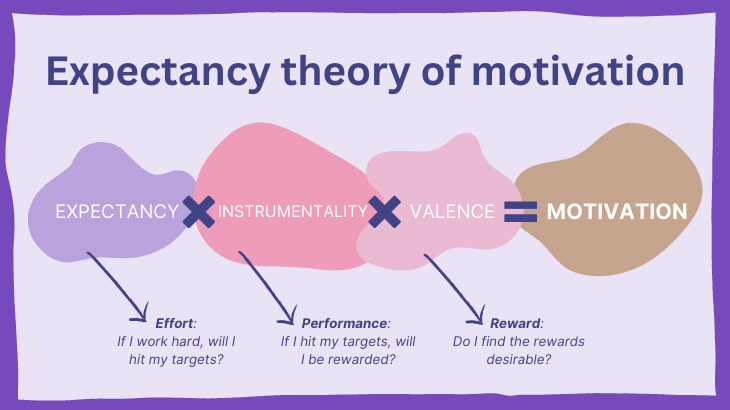One of your most important responsibilities as a manager is to ensure your team stays motivated and engaged. But how do you accomplish this?

You need to identify the X factor that leads employees to produce excellent work and stay productive. Often, the motivating factor is a belief that the employee will receive a valuable reward in exchange for their hard work.
Expectancy theory suggests people are more likely to be motivated and go the extra mile if they know their efforts will be recognized and rewarded. But it’s not just any reward — it’s a benefit that is specifically desirable to the person.
People want their efforts and hard work to lead to success. Without a clear reward, people tend to not choose a certain path.
It’s easy to see why expectancy theory is popular in the workplace. Managers want their employees to put effort into their work and providing a desirable reward for their work is often key to their motivation.
For example, many organizations implement incentives, such as performance-based pay. Employees may work harder if they know their performance will be rewarded with bonuses or commissions. In theory, performance-based pay can increase the motivation of employees and, subsequently, improve productivity and participation.
Expectancy theory has remained popular since its introduction in 1964 by Victor Vroom. People often view it as the most comprehensive explanation of motivation.
Understanding people’s motivations and what they find desirable as rewards are key to creating a work environment where employees thrive. Managers use expectancy theory to motivate employees by showing them how hard work correlates with their desired rewards. Along with a supportive work environment, this is often key to improving the overall work output from your employees.
However, expectancy theory is more of a framework than a step-by-step motivational plan. Your company culture and the varying desires of employees mean expectancy theory can look different for every organization.
Expectancy theory identifies three elements that determine why people choose a specific behavior over other options. These three elements are:
Expectancy is the belief that a person’s efforts will lead to better performance. This can be dependent on the person’s perception of whether they have the tools and environment they need to achieve their goal.
There are usually four factors contributing to a person’s expectancy:
Instrumentality is the belief the person will receive a reward for meeting expectations. Instrumentality increases when managers make the effort to ensure employees will receive the reward.
Managers can do this by:
This element is highly dependent on the individual’s values and desired outcomes. The reward needs to align with what they want or it won’t increase motivation.
Valence is affected by preferential factors. Managers need to identify what their employees prefer as a reward. The answer is different for every employee and team.
Keep in mind, valence isn’t related to an actual level of satisfaction, but rather the expected satisfaction of receiving a reward.
The expectancy theory formula identifies a person’s highest motivational force. When choosing between options, a person will choose the path with the greatest motivational force.
This can be difficult for managers to determine, but the expectancy theory formula can help with finding your employees’ motivational force:

The formula for expectancy theory is:
Motivational force (MF) = Expectancy * Instrumentality * Valence
The three elements of expectancy theory are crucial to discover before you can start using it in the workplace. While expectancy and instrumentality are based on attitudes and perceptions, valence is entirely dependent on an individual’s value system. Managers need to know what outcomes are valuable to their employees.
Some examples of common desirable outcomes for employees include:
If you notice poor motivation among employees, you may need to adjust your implementation of the expectancy theory. You may have misjudged the motivational forces of your employees or don’t have any type of clear reward system in place.
Implementing expectancy theory effectively in the workplace can lead to increased motivation and productivity among your employees. Doing so requires you to understand and cater to the unique needs and motivations of your team members.
The tips and best practices below will help you foster a work environment where employees feel valued and inspired:
One of the most essential aspects of implementing expectancy theory in the workplace is to accurately identify team motivators. If you don’t, then managers won’t be able to design effective incentive programs.
There are a few ways to find your employees’ motivational force:
You also may want to consider periodically reviewing your employees’ motivational force because it can change over time.
Don’t make promises you can’t keep. For example, perhaps you become aware that several members of your team would like to work from home, but this goes against company policy. Or, maybe they would like bonuses, but your company has set limits on how much you can give.
In situations like this, you may need to ask to revise company policy or alter the expectations of your rewards to ensure alignment.
One of the factors of the expectancy element is difficulty. If employees feel like their task is too difficult for them to accomplish, they may not attempt to do it.
Creating attainable goals is an important part of improving employee motivation. On the other hand, you still want to make goals challenging to keep employees interested in their work.
Another important factor of goal-setting is ensuring your employees have the skill set to accomplish the goals. This helps with the confidence factor of the expectancy element.
When employees are confident they have the skills to meet job expectations, they are more likely to succeed. This may mean assigning specific tasks to a person’s unique skill set.
Implementing the instrumentality element is a factor completely controlled by managers. You are in charge of communicating to employees how their efforts will lead to rewards.
Transparency is crucial for employees, or they might not believe they will receive the reward. Make quotas and other measurable statistics easily available to employees so they can understand what they need to do to receive the reward.
A lack of communication can cause distrust, so it’s important to set these expectations clearly from the beginning.
A common criticism of expectancy theory is that it’s too simplistic to explain a person’s reason to perform. This is especially true for large teams with individuals with varying needs or desires for their careers.
For example, one employee could have a strong desire to get a promotion and eventually work at a C-suite level. However, another employee might find promotions undesirable because they don’t want to work in management. This may cause them to lower their work efforts to avoid promotion.
Expectancy theory may only work if you identify each person’s motivational force.
Beyond expectancy theory, there are a couple of other popular motivational theories to consider:
Maslow argued humans have five essential needs that build on top of each other and define a person’s behavior: survival, security, belonging, importance, and self-fulfillment.
In the workplace, employees who are only having their survival and security needs met are often unmotivated by their work. Managers may improve motivation by fulfilling Maslow’s hierarchy of needs to ensure job satisfaction
Herzberg theorized two factors that influence employee satisfaction: hygiene and motivation.
Hygiene refers to elements that can cause dissatisfaction, such as relationships with peers, workplace, salary, and company policies. Motivating factors can cause satisfaction such as achievement, recognition, enjoying the work, and growth opportunities.
By addressing hygiene factors and reinforcing motivating factors, you may improve employee productivity and satisfaction
For expectancy theory to be useful, you need to identify what rewards will motivate your team. Keep in mind, this will be different for everyone.
You also need to clearly define expectations surrounding work efforts and positive outcomes. It’s also crucial to ensure employees have the support and resources they need to achieve these goals.
Because expectancy theory will be different for each employee, this may require you to spend more time getting to know you employees’ individual needs and motivations. It may also involve identifying factors that are getting in the way of an employee’s job satisfaction and motivational force.
When executed properly, expectancy theory can be a great way to reward high-performing team members and encourage other employees to perform at their best.

LogRocket identifies friction points in the user experience so you can make informed decisions about product and design changes that must happen to hit your goals.
With LogRocket, you can understand the scope of the issues affecting your product and prioritize the changes that need to be made. LogRocket simplifies workflows by allowing Engineering, Product, UX, and Design teams to work from the same data as you, eliminating any confusion about what needs to be done.
Get your teams on the same page — try LogRocket today.

Stop letting unreliable data block features. Treat data as inventory to track quality, ownership, and ship with confidence.

Learn why slide decks slow teams down and explore better tools like whiteboards, PRDs, and prototypes to improve collaboration and alignment.

AI PM roles are evolving fast. Learn the five types of AI PMs, the skills they need, and how they shape AI products across industries.

Learn how you can use AI agents to automate workflows, boost productivity, and choose the right tools while avoiding common pitfalls.